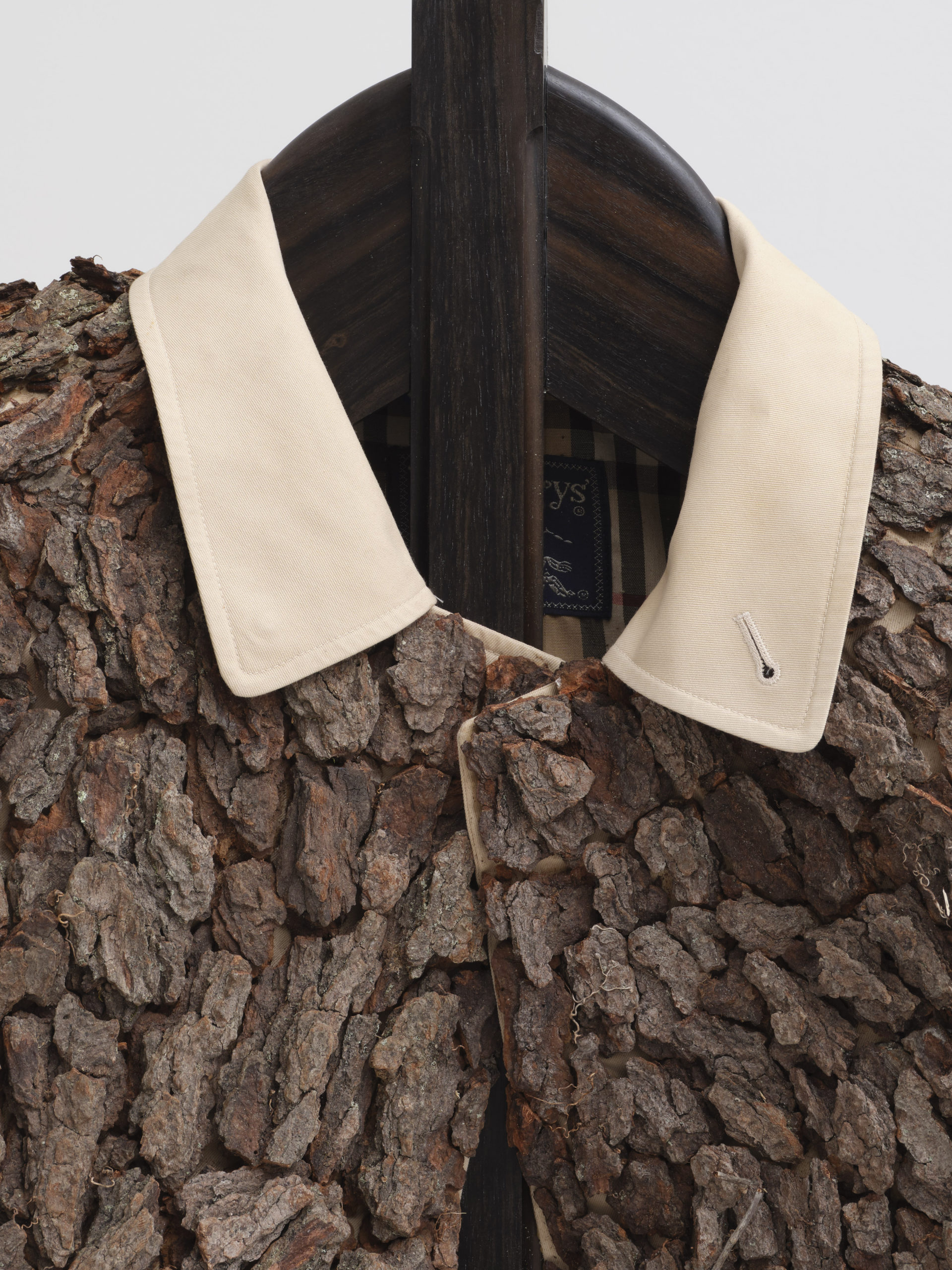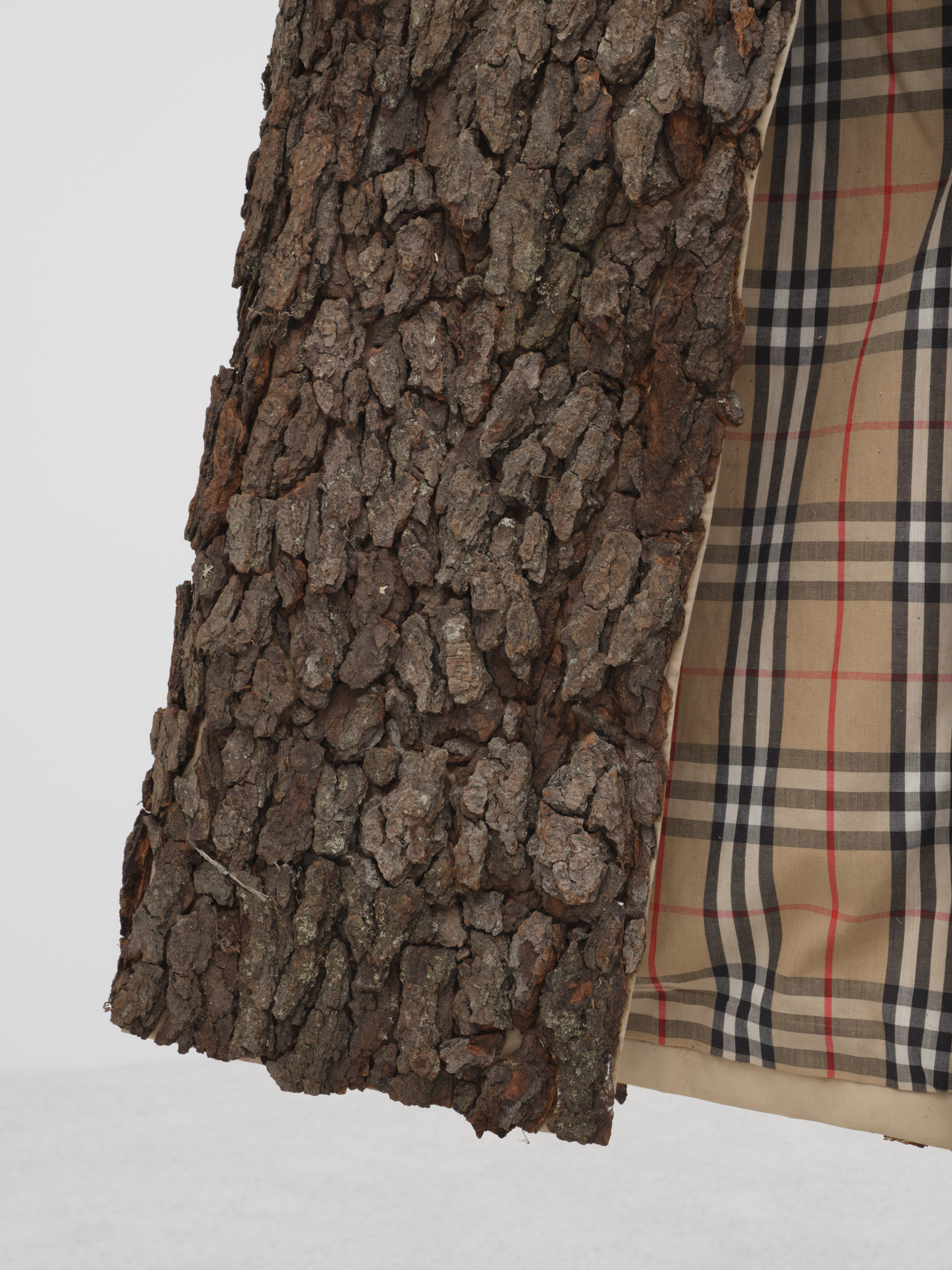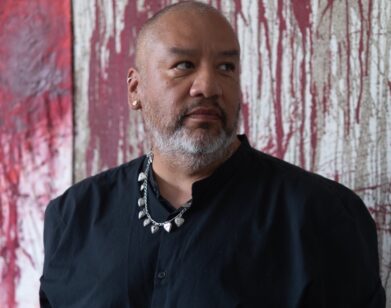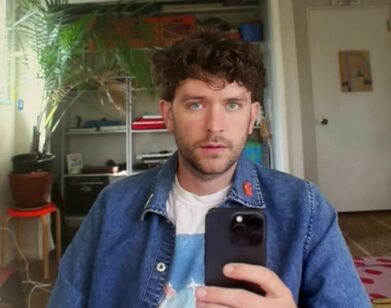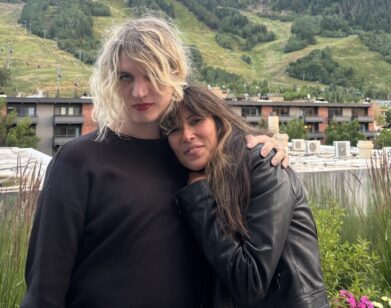art!
Meet Hugh Hayden’s Lurking “Boogey Man”
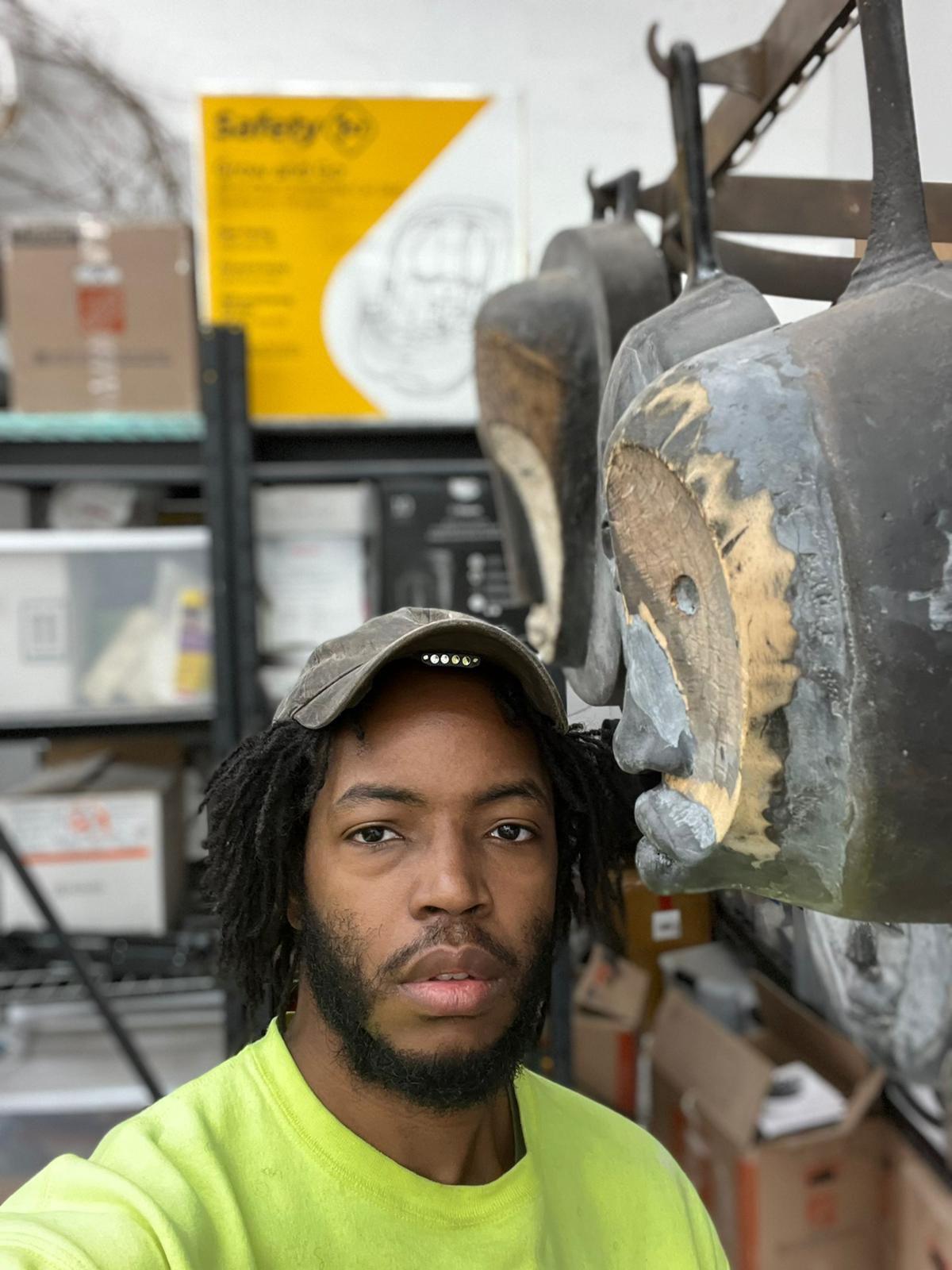
Photo courtesy of Hugh Hayden.
Nobody reveals the ambiguity of the American Dream like Hugh Hayden does. His sculptures—looming, eerily anthropomorphic monuments—explore the relationship between African American identities and American culture. This relationship, through Hayden’s eyes, is one of simultaneous joy and anguish, dream and nightmare, life and death. With “Boogey Man,” the sculptor’s current exhibition on view at ICA Miami, Hayden (a carpenter by trade) mixes mediums—a police car shrouded in a Klan-like hood, cypress branches woven into skeletal forms—to evoke new facets of American identity. To learn more about the exhibition, we sat down with the artist for a conversation about complex processes, ownership, and dreams—good and bad.
———
ALEXANDRE STIPANOVICH: “Boogey Man” is incredible. I want to ask you about the titular piece, the hooded car. There’s a police car under the ghost draping. How did this idea come about? Why did you use steel this time?
HUGH HAYDEN: Thanks for asking me to speak about the exhibition! As I mature as an artist, I’m moving away from saying, “This means this, and that means that.” However, it’s impossible for an artist’s work to be completely abstract and devoid of all meaning. I kind of like everyone to have a different perspective. But I’ve had the idea of this piece for a while…more than four years. I made some maquettes based on toy police cars that I had purchased online. I explored using plaster bandages to get a sense of what it might look like. Does the idea translate? Is it successful? While the work itself is not made out of wood, this piece is in a way similar to the skillet pieces of pots and pans, where I recast African masks into metal. In that way, there is an original, historical form that is reshaped and slightly abstracted into metal. You still have some facsimile of the thing that’s being referenced, but you’re also transforming it into something else. It wasn’t a huge leap. I mean, mainly it was the scale that was a challenging.
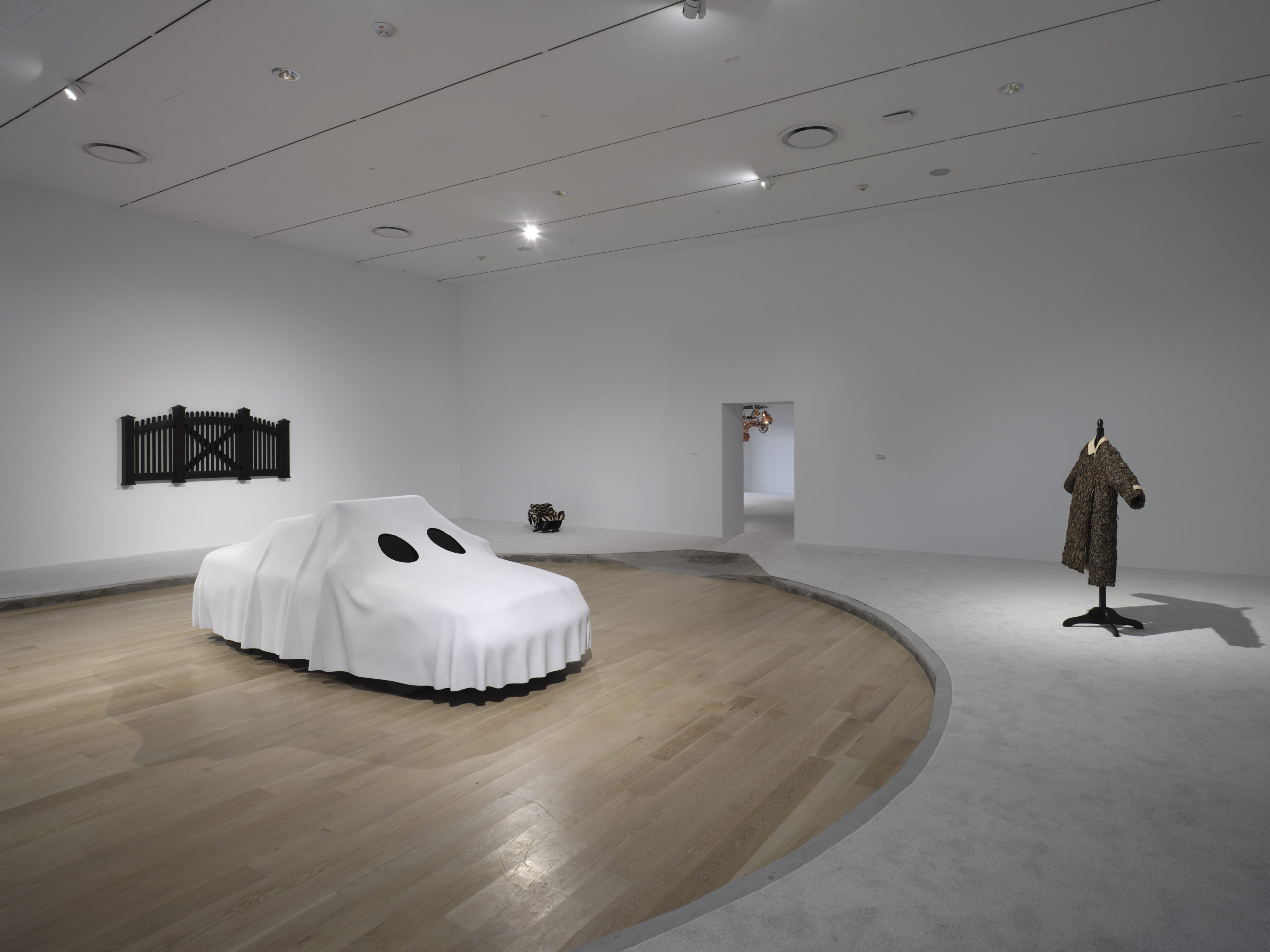
Hugh Hayden: Boogey Men, Exhibition view. ICA Miami. November 30, 2021 – April 17, 2022. ©️ Hugh Hayden, Courtesy Lisson Gallery.
STIPANOVICH: Can you comment on the piece’s title?
HAYDEN: Do police in this country create ghosts? Or are they also ghosts themselves, you know? It’s about perspective. “Boogey Man” is something a child would say, versus an adult. Who would call a police officer a Boogey Man? Who would be raised to think that this person is a monster? There is a particular style of police car, the Crown Victoria, that was everywhere during my adolescence in Dallas. That style of police car represents a particular era—[in the exhibition,] we’ve actually distorted it. It’s 75% smaller than the real car, and it’s deliberately out of proportion between the length and the height to give a more cartoony impression. That it makes it more humorous and fun. People still think there’s a car under it, and they can’t imagine that it’s metal either.
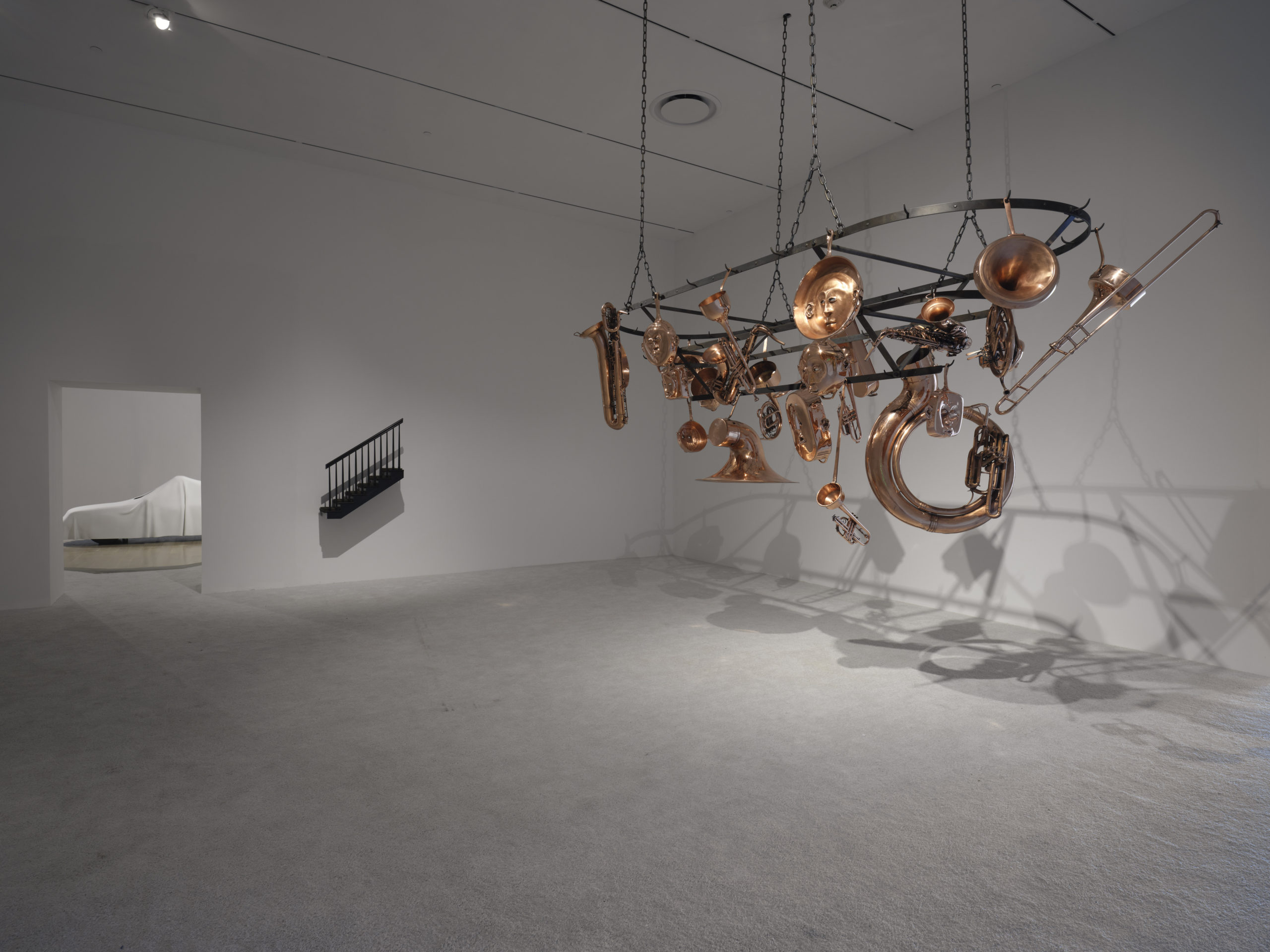
Hugh Hayden: Boogey Men, Exhibition view. ICA Miami. November 30, 2021 – April 17, 2022. ©️ Hugh Hayden, Courtesy Lisson Gallery.
STIPANOVICH: What about the “Brass Ensemble”? It has a much more festive spirit than “Boogey Man.”
HAYDEN: They are 12 pairs of pots and pans—cast-iron skillets with African masks on them—each paired with an attached brass instrument. Those are then re-plated in their entirety in copper. It’s this ensemble of musicians with their instruments, if you will. There are 24 pieces, but I consider them 12 musicians paired with 12 instruments. The work is about not only the creation of food, music, and overall culture in the United States, but more about the African origins of culture, food, and music in the United States. The pot is sort of the container for creating this melting pot stew that is America. A lot of my work has to do with the American Dream—how it’s something desirable that you want to be a part of. “Boogey Man” might appear cutesy and benign, but at the same time there’s something undesirable and dangerous lurking. There is this duality of desirable and undesirable, or inviting and uninviting, that appears in a lot of my work in different ways.
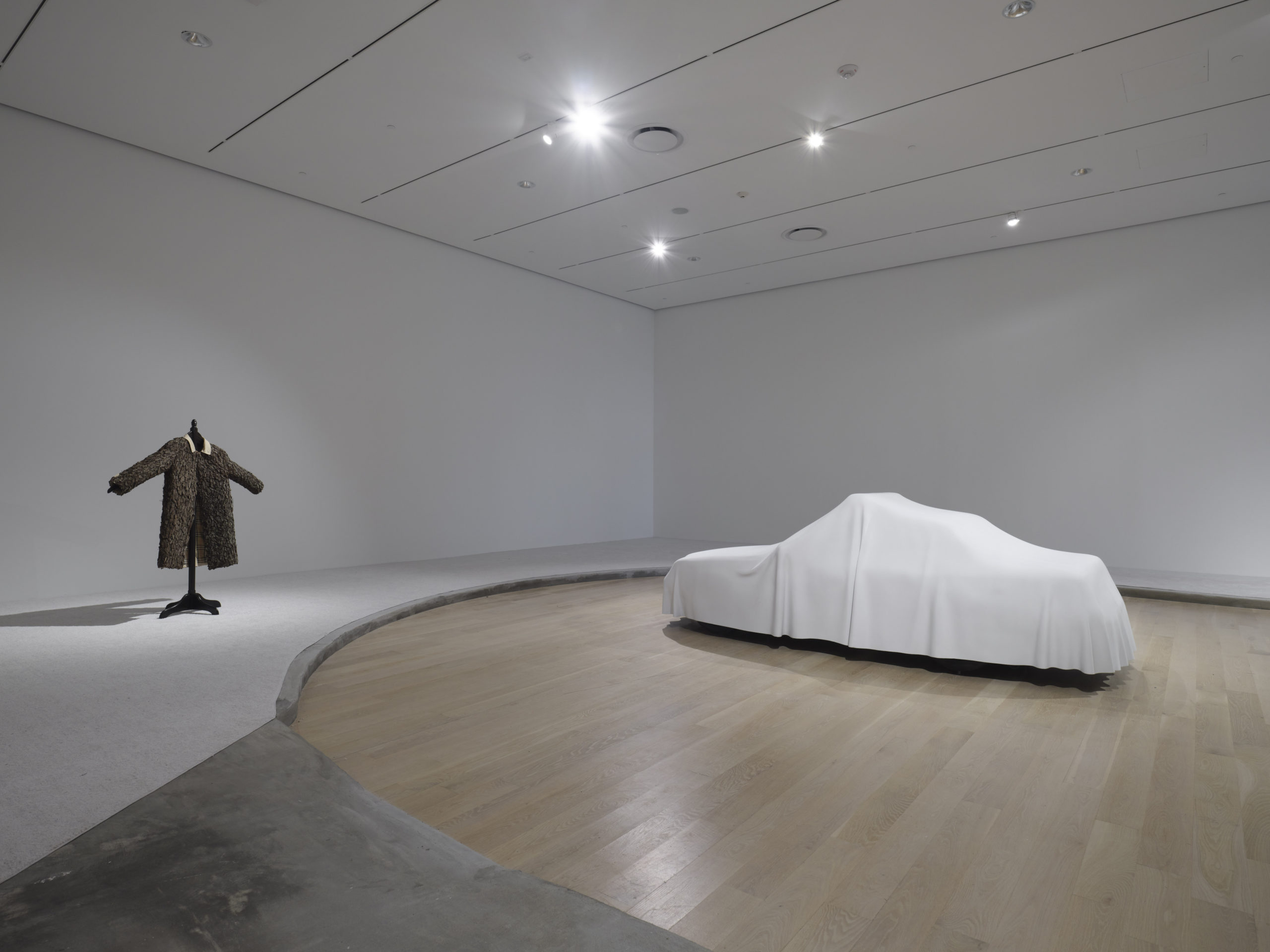
Hugh Hayden: Boogey Men, Exhibition view. ICA Miami. November 30, 2021 – April 17, 2022. ©️ Hugh Hayden, Courtesy Lisson Gallery.
STIPANOVICH: Speaking of that duality, the two rooms in the gallery have different vibes.
HAYDEN: Yeah. The show is divided into two rooms. The first space you enter is like this cul-de-sac. There’s a concrete curb with a carpeted lawn, the things outside of a home. This ghost police car sits outside. On the inside, there’s a kitchen, a staircase, and a reclining skeleton, which I now call “Nude Over Past Roots.” It’s the idea of a family tree, with connections to nature. My attraction to skeletons is not about death. It’s more this idea that it could be anyone—we all have a skeleton. Likewise, these leafless branches could be any type of tree. So for me, this could be anyone’s home in America. Alternatively, this is a Black experience. I mean, there are different ways of approaching this notion of inhabiting America.
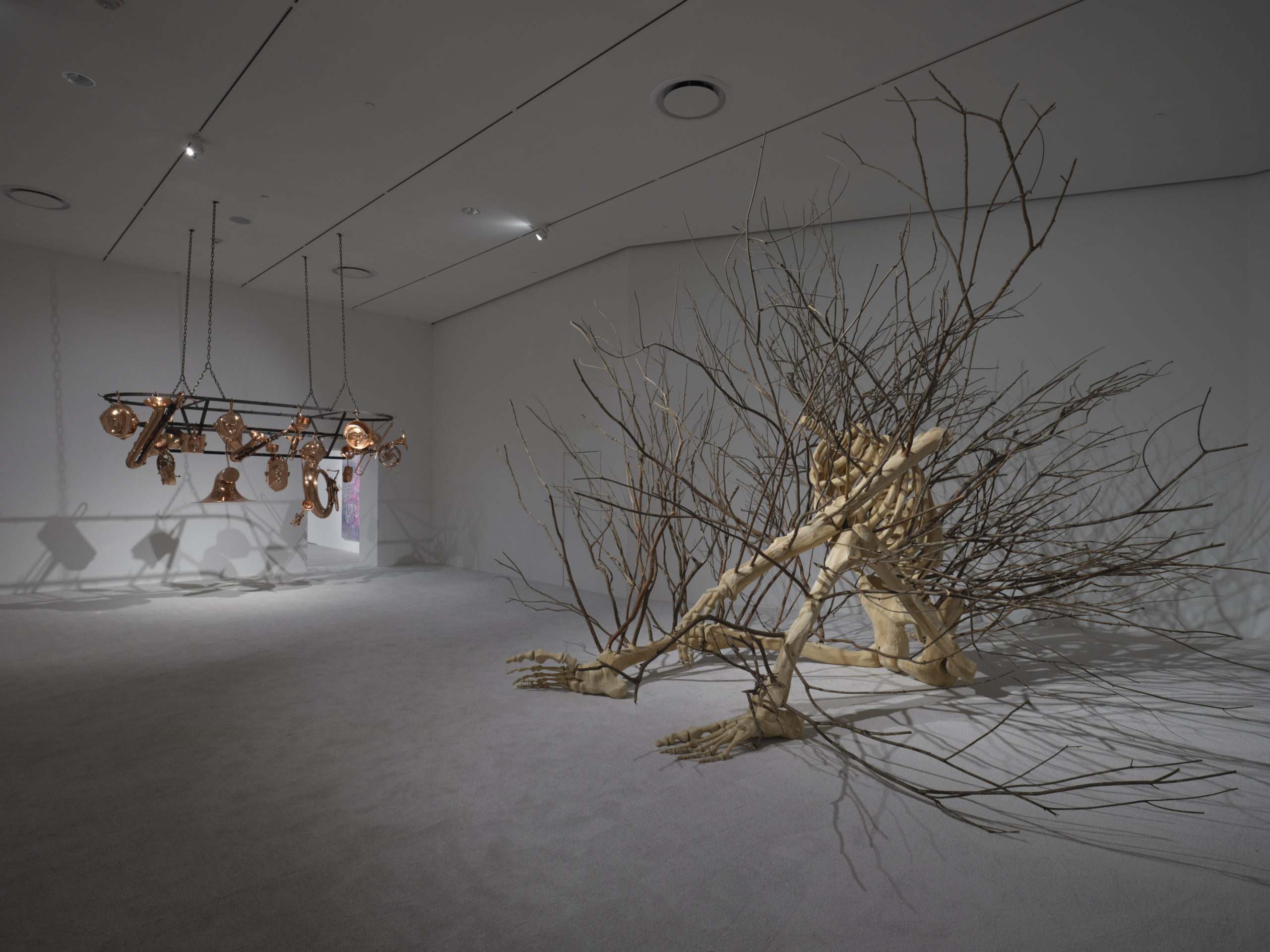
Hugh Hayden: Boogey Men, Exhibition view. ICA Miami. November 30, 2021 – April 17, 2022. ©️ Hugh Hayden, Courtesy Lisson Gallery.
STIPANOVICH: The skeleton’s position is intriguing. It looks like it’s thinking or daydreaming.
HAYDEN: Yeah, or trying to relax, or leaning back on the couch.
STIPANOVICH: Or even listening to the ensemble, maybe?
HAYDEN: Oh yeah, I like that. Like a harmony.
STIPANOVICH: This piece must have been very difficult to produce.
HAYDEN: Oh yeah. Everything in the show had its challenges, but this was particularly challenging. The big pieces took close to a year to make, because typically, with lumber, branches are the first parts removed. Lumber is an abstraction of a tree. It’s a lot of work just sourcing the wood, finding someone who could procure the wood per my specifications, keeping it in intact, and transporting it. Then, working with the wood that has the branches attached is also a challenge. It is an exercise to achieve the final effect, which is hopefully that the viewer is left not knowing how this is made. The piece just arrived. You don’t even know how to approach it. Someone early on pointed out that when you can’t even begin to guess how the piece is made, it automatically transports you to another place. It’s the idea that art can transform you.
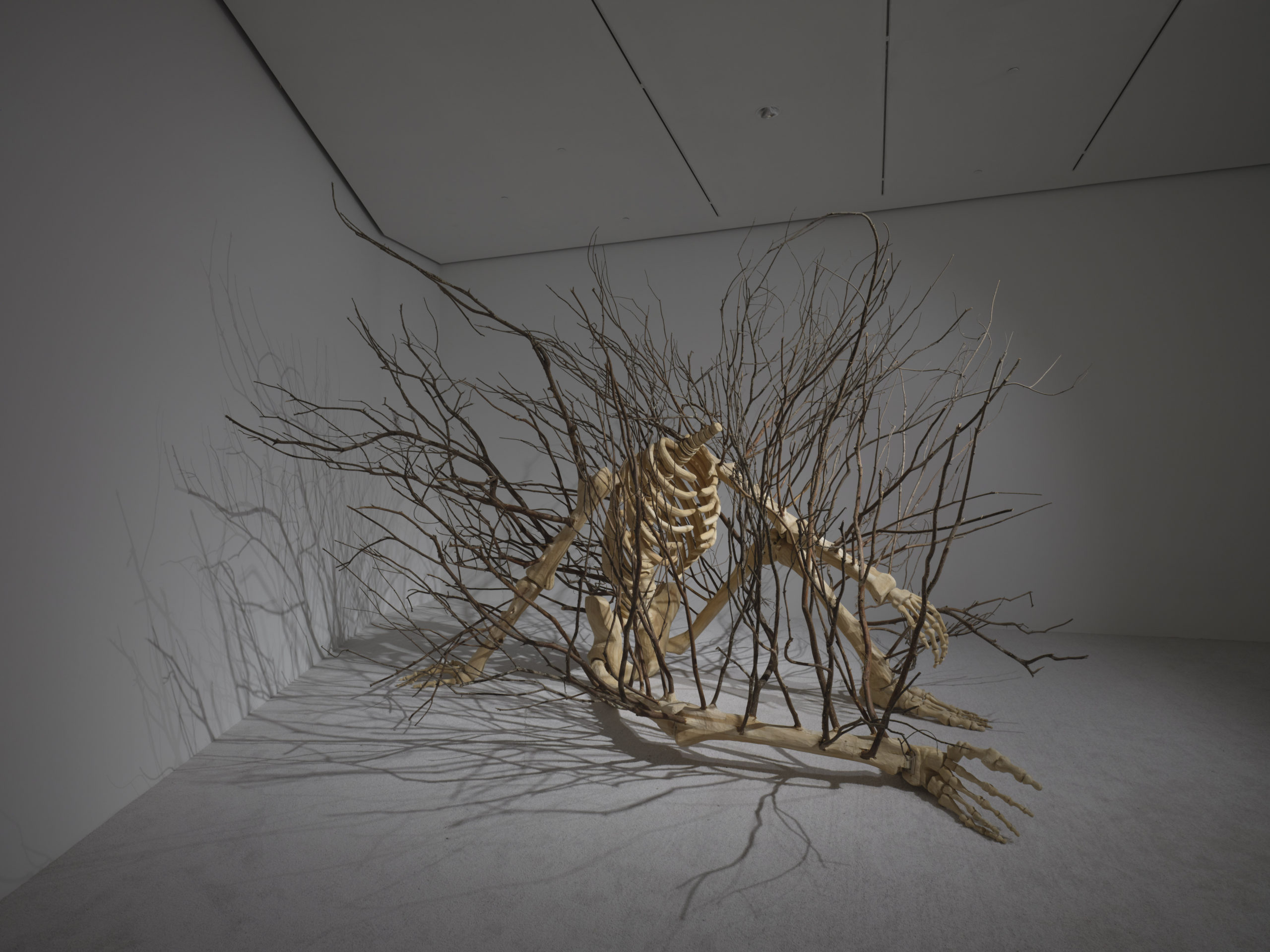
Hugh Hayden: Boogey Men, Exhibition view. ICA Miami. November 30, 2021 – April 17, 2022. ©️ Hugh Hayden, Courtesy Lisson Gallery.
STIPANOVICH: It’s definitely puzzling to think how you produced this.
HAYDEN: It’s a lot of hard work. Most of the people who’ve worked with me can’t get over how difficult it is. They say, “Why would you want to do that?” There are a lot of people who hang up, “No, we can’t help you.” In this particular installation, I was using bald cypress trees from Louisiana—they grow from Florida to Texas, where I’m from. It was just a challenge finding someone who had access to these trees, and who would cut them down in a certain way. And eventually we did find someone, he had been on a TV show called Ax Men. There was a family who lived in a swamp outside of New Orleans in the 1800s. They would cut them down up river, and they would float the logs down to a sawmill. A percentage of them would sink in the river, and some of them would start a petrification process. Or they would age in some way, that now 200 years later, people are digging them up for this new, transformed cypress lumber called Sinker Cypress. There’s a whole cottage industry around this product now. I figured if someone would go through this much trouble to find and harvest wood, they might be into working with me on this project, collecting this wood. I’m happy they were convinced to help me out.
- Scarecrow, 2021 Cherry bark on Burberry coat on Gabon ebony rack. 72 x 18 x 60 in ©️ Hugh Hayden, Courtesy Lisson Gallery.
STIPANOVICH: What about the Burberry coat scarecrow facing the ghost police car? That’s another element of fear.
HAYDEN: I made the first version of that almost 10 years ago. I have a piece in my studio, called “Armor,” which is a Burberry raincoat been covered with similar bark. It’s this idea of camouflage. For me, it’s a way of assimilation, or blending into a certain class, or group—because Burberry is a luxury brand. It’s about looking the part, especially juxtaposed to the police car. If you look a certain way, you won’t have any trouble.
STIPANOVICH: How was the bark put together? It looks like a delicate process.
HAYDEN: It pretty much is. That’s just what goes into making it look believable. I don’t want to get too much into how it’s made, but the first part is procuring the bark. I have a guy upstate at a lumberyard who lets me chisel the bark off of his logs before he processes them. Then he dries them for me in a kiln for two weeks to kill any parasites or insects. Then it’s a puzzle to figure out a way to completely cover the existing surface.
STIPANOVICH: It has a ghostly presence. Between that, the car, and the skeleton, there are many ghosts in this show…
HAYDEN: Yeah, a lot of things are in the air— in terms ghosts, or things suspended in the air.
STIPANOVICH: And there’s a chair on fire titled “America.”
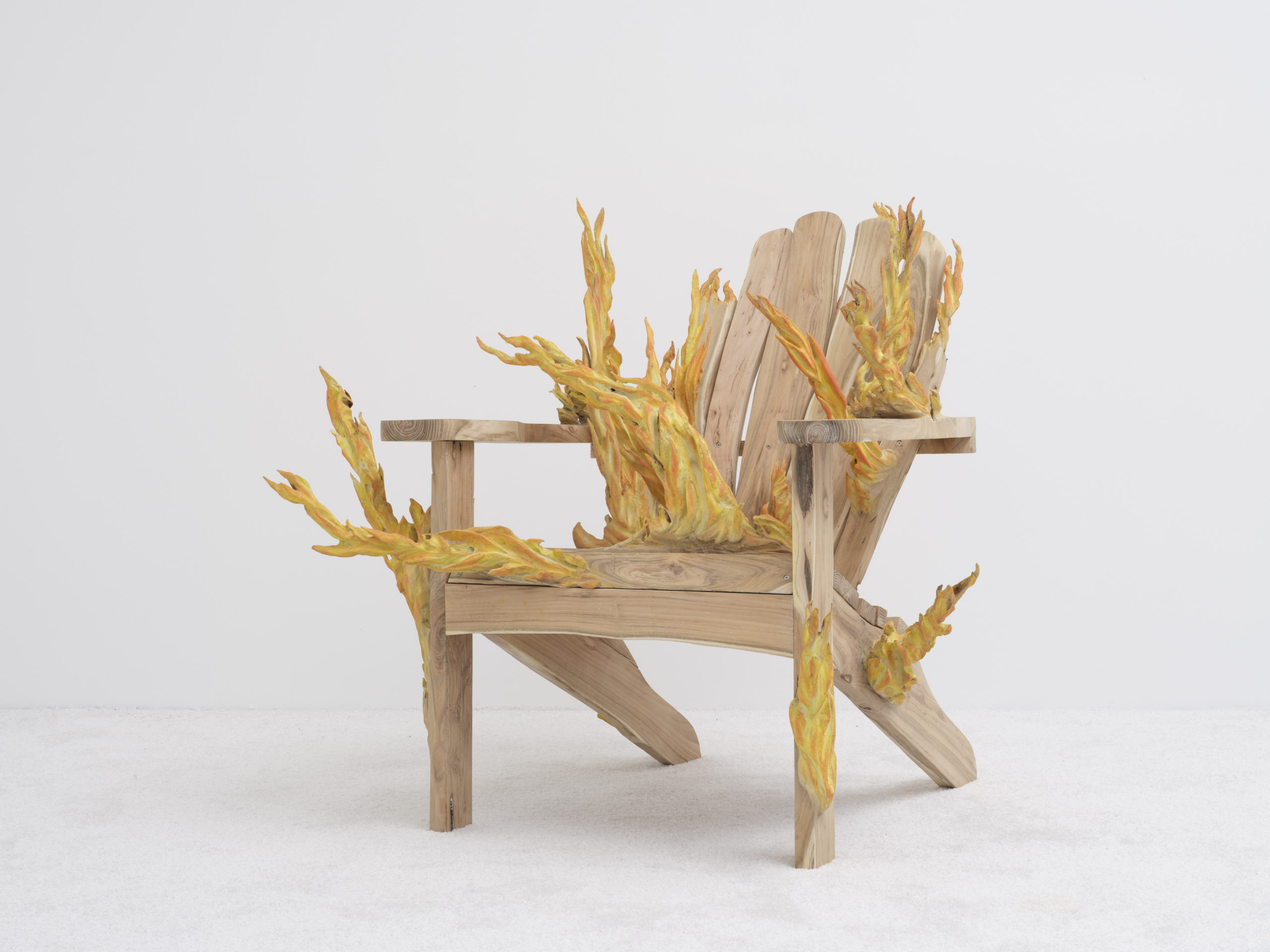
America, 2021. Black locust, milk paint, 60 x 60 x 60 in. ©️ Hugh Hayden, Courtesy Lisson Gallery.
HAYDEN: It’s an Adirondack chair made of wood, and the branches are sculptured into flames. You can take it how you want. People put Adirondack chairs in their yard to relax and enjoy their exterior space. That chair is the symbol of land ownership, or property—the American Dream, or the suburban dream. Here, that dream is up in flames, so that’s about about the difficulty of inhabiting that. Many people of my generation may never be able to own a home, have a yard.
STIPANOVICH: Are these flames of anguish, because that privilege is built on other people’s lives? Are they flames of inaccessibility, because some people will never afford that dream?
HAYDEN: It could be those. It’s both inaccessible, or it’s someone protecting this dream from other people. That dream isn’t possible anymore.

